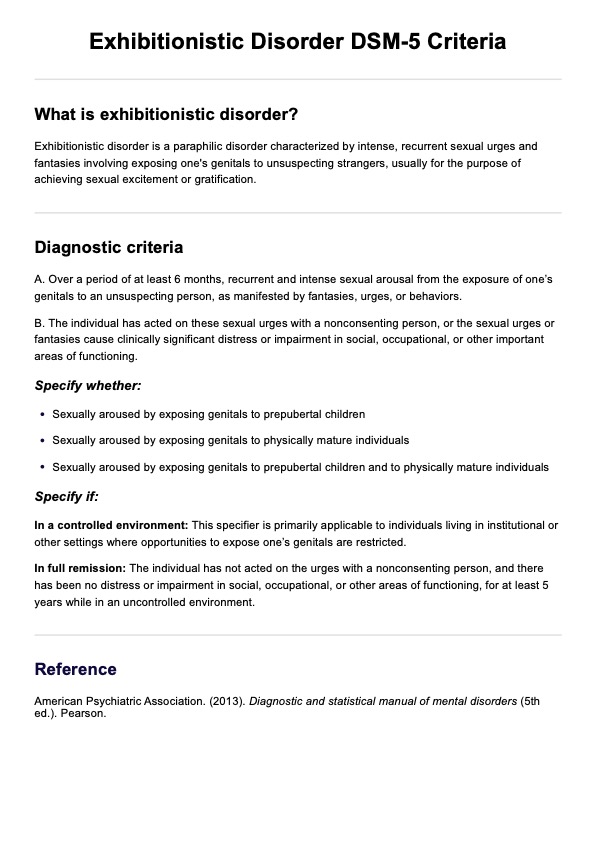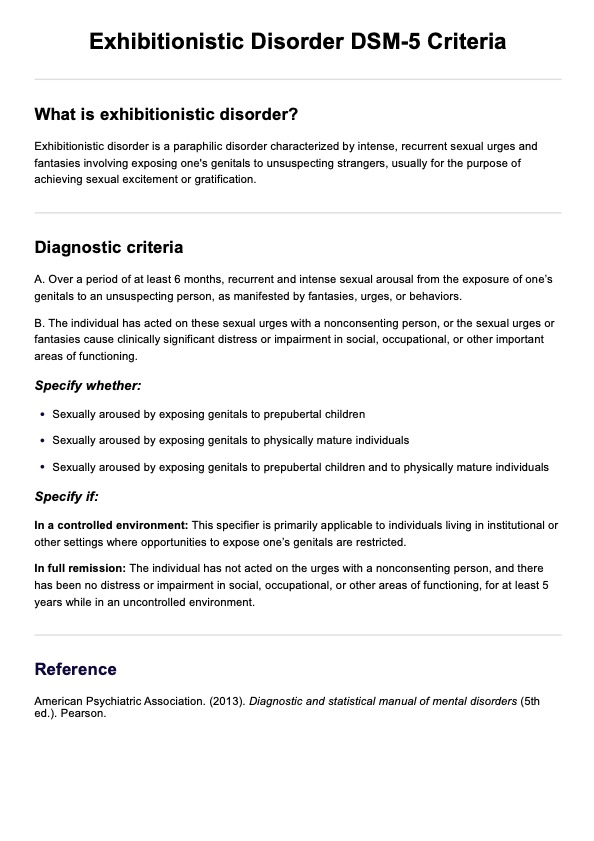Exhibitionistic Disorder DSM-5 Criteria
Use a helpful reference tool when diagnosing or ruling out paraphilic disorders among patients with our Exhibitionistic Disorder DSM-5 Criteria.


What is exhibitionistic disorder?
Exhibitionistic disorder is a paraphilic disorder characterized by recurrent, intense sexual arousal from exposing one's genitals to unsuspecting people. According to the Diagnostic and Statistical Manual of Mental Disorders, Fifth Edition (DSM-5), this pattern must persist for at least six months and cause significant distress or impairment in functioning (American Psychiatric Association, 2013a).
It primarily affects males and often begins in adolescence or early adulthood. While not all individuals who engage in exhibitionistic behavior meet the full diagnostic criteria, those who do may require professional intervention to manage their urges and behaviors effectively.
Exhibitionistic Disorder DSM-5 Criteria Template
Exhibitionistic Disorder DSM-5 Criteria Example
How is exhibitionistic disorder diagnosed?
Exhibitionistic disorder is diagnosed using criteria outlined in the DSM-5. The diagnosis requires persistent, intense sexual arousal from exposing one's genitals to unsuspecting persons, lasting at least six months. More importantly, the individual must have acted on these urges with a nonconsenting person, or the urges and intense sexually arousing fantasies must cause clinically significant distress or interpersonal difficulties (American Psychiatric Association, 2013a).
Diagnosis typically involves a comprehensive clinical assessment, including a detailed history of sexual behaviors, fantasies, and any associated distress. Clinicians should also evaluate for co-occurring mental health conditions and substance use disorders, which are common in individuals with exhibitionistic disorder.
It's crucial to differentiate between occasional exhibitionistic behavior and the disorder itself. Not all individuals who engage in exhibitionistic acts meet the full diagnostic criteria. The diagnosis does not apply to those in controlled environments where exposure opportunities are limited, such as institutional settings.
DSM-5 exhibitionistic disorder diagnostic criteria
The DSM-5 provides specific criteria for diagnosing exhibitionistic disorder, ensuring a standardized approach to identification and treatment. These criteria distinguish between occasional exhibitionistic behavior and a clinically significant disorder.
According to the DSM-5, exhibitionistic disorder is characterized by:
A. Over a period of at least 6 months, recurrent and intense sexual arousal from the exposure of one’s genitals to an unsuspecting person, as manifested by fantasies, urges, or behaviors.
B. The individual has acted on these sexual urges with a nonconsenting person, or the sexual urges or fantasies cause clinically significant distress or impairment in social, occupational, or other important areas of functioning.
The DSM-5 also specifies three subtypes of exhibitionistic disorder:
- Exhibitionistic disorder, sexually aroused by exposing genitals to prepubertal children
- Exhibitionistic disorder, sexually aroused by exposing genitals to physically mature individuals
- Exhibitionistic disorder, sexually aroused by exposing genitals to both prepubertal children and physically mature individuals
Differences between the DSM-4 and criteria
The transition from DSM-IV to DSM-5 brought several notable changes to the diagnostic criteria for exhibitionistic disorder, reflecting evolving understanding and research in the field of paraphilic disorders.
DSM-5 introduced a distinction between paraphilias and paraphilic disorders. In this framework, exhibitionism is considered a paraphilia, while exhibitionistic disorder is a diagnosable condition. This change recognizes that atypical sexual interests are not inherently pathological unless they cause distress or impairment.
In DSM-IV, the condition was referred to as "exhibitionism," while DSM-5 uses the term "exhibitionistic disorder." This shift emphasizes that the diagnosis applies to a clinical disorder rather than just a pattern of behavior (American Psychiatric Association, 2013b).
Associated disorders with exhibitionistic disorder
Exhibitionistic disorder often coexists with other mental health conditions, complicating diagnosis and treatment.
Other paraphilic disorders
Paraphilic disorders frequently co-occur with exhibitionistic disorders. For instance, many individuals experience arousal from both exposing themselves and observing unsuspecting others, such as in voyeuristic disorders. Other paraphilic disorders, such as frotteuristic disorder and sexual masochism disorder, may also be present in some cases.
Mood disorders
Mood disorders, especially bipolar disorder, are common among individuals with exhibitionistic disorder. These conditions may exacerbate exhibitionistic behaviors or emerge as a result of the distress and social isolation often associated with the disorders.
Anxiety disorders
Anxiety disorders can also frequently co-occur with exhibitionistic disorder. The stress of managing urges and the fear of discovery can contribute to heightened anxiety levels.
Substance use disorders
Substance use disorders are another significant concern. Some individuals may use alcohol or drugs to lower inhibitions before engaging in exhibitionistic behaviors or to cope with the aftermath of their actions.
How is exhibitionistic disorder treated and managed?
While there's no one-size-fits-all solution, several evidence-based strategies have shown promise in helping individuals manage their urges and behaviors effectively.
Psychotherapy
Cognitive-behavioral therapy (CBT) is often the first-line treatment for exhibitionistic disorder. CBT helps individuals identify and change problematic thought patterns and behaviors. Techniques such as cognitive restructuring and relapse prevention strategies can be particularly effective.
Pharmacological interventions
Medication can play a crucial role in managing exhibitionistic urges. Selective serotonin reuptake inhibitors (SSRIs) have shown efficacy in reducing sexual preoccupations and compulsive sexual behaviors. In more severe cases, antiandrogen medications may be considered to reduce sexual drive.
Group therapy
Participating in group therapy sessions can provide individuals with support, accountability, and the opportunity to learn from others facing similar challenges. These sessions often focus on developing coping strategies and improving interpersonal skills.
Behavioral modification
Techniques such as aversion therapy or covert sensitization may be employed to reduce the association between exhibitionistic behaviors and sexual arousal. However, these approaches should be used cautiously and in conjunction with other treatment modalities.
Ongoing monitoring and support
Long-term management of exhibitionistic disorder often requires ongoing monitoring and support. Regular check-ins with mental health professionals can help individuals maintain progress and address any emerging challenges promptly.
References
American Psychiatric Association. (2013a). Diagnostic and statistical manual of mental disorders (5th ed.). Pearson.
American Psychiatric Association. (2013b). Highlights of changes from DSM-IV-TR to DSM-5. American Psychiatric Association. https://www.psychiatry.org/File%20Library/Psychiatrists/Practice/DSM/APA_DSM_Changes_from_DSM-IV-TR_-to_DSM-5.pdf
Commonly asked questions
Is exhibitionism a mental disorder?
Exhibitionism is considered a mental disorder only when it meets the criteria for exhibitionistic disorder as defined in the Diagnostic and Statistical Manual of Mental Disorders (DSM-5). It is essential to determine whether the behaviors meet the diagnostic criteria for exhibitionistic disorder, as not all exhibitionistic acts qualify as a disorder.
The criteria for exhibitionistic disorder, according to the DSM-5, include recurrent and intense sexual arousal from the exposure of one's genitals to unsuspecting individuals, in which fantasies, urges, or actual behaviors can be evidence. To qualify for the diagnosis, the individual must have acted on these urges with a nonconsenting person or experienced significant distress or impairment in social, occupational, or other important areas of functioning due to the urges. Additionally, these symptoms must be present for a duration of at least six months.
Assessing for exhibitionistic disorder involves a comprehensive clinical evaluation that includes a detailed history of the individual's sexual behaviors, fantasies, and any associated distress or impairment. Clinicians should inquire about the frequency and context of the exhibitionistic behaviors, as well as any co-occurring mental health conditions.





















-template.jpg)


















































































